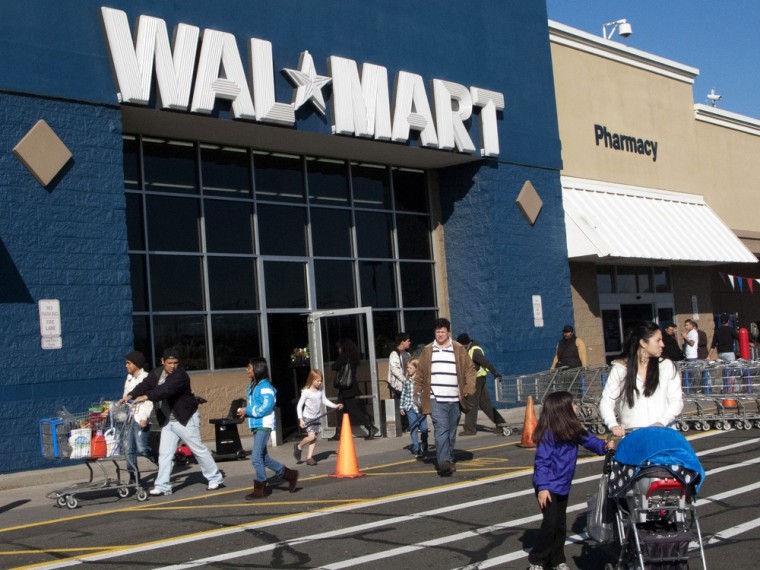Wal-Mart’s surprise drop in sales and cautious outlook for the rest of the year revealed a troubling new side to the economy: American consumers may be driving the recovery forward, but lower-income households are being left behind.
(Read more: Wal-Mart sales slip, outlook 'cautious')
"During the first half of the year, we saw consumers in both mature and emerging markets curb their spending, and we believe these trends will persist through the remainder of the year," Wal-Mart's chief financial officer Charles Holley said.
That's not what's happening to overall consumer spending, according to the Commerce Department, which reported earlier this week that retail sales rose 0.2 percent in July. The government's so-called "core" spending index—which excludes cars, gasoline and building materials—posted its largest gain in seven months, rising 0.5 percent.
The conflicting picture, some analysts say, is coming from two very different groups of American households.
"You're seeing a bit of a split economy where that lower income consumer has been under a lot of pressure but the higher end is doing OK," said Joe Feldman, a senior research director at the Telsey Advisory Group. "You're seeing borrowing is increasing actually for auto loans, for house loans. There is capacity to spend, but it's the high end that's getting that lending to spend. It's really the lower end where you're seeing a lot of pressure."
That pressure is a major drag holding back the tepid recovery from the Great Recession that has been marked by slower growth and higher unemployment than any rebound in the last 50 years.
(Read more: Summertime, and the consumer spending ain't easy)
Recent cuts in federal spending haven't helped. But with consumer spending driving nearly 70 percent of gross domestic product, a return to "normal" economic growth can't happen without stronger household spending.
Earlier this year, a pickup in demand for housing and cars sparked optimism that the American consumer was slowly digging out from a long, debt-burdened spending drought that lingered long after the recession ended three years ago. But the recovery has yet to reach the lower end of the income ladder.
After peaking at 10 percent in October 2009, the unemployment rate has fallen slowly but steadily to 7.4 percent last month. But much of the employment created since the recession ended has come from low-wage jobs in the service sector. More than half of the new jobs created in July, for example, were in the retail or leisure and hospitality industries.
Overall, earnings tightened considerably last month for households living paycheck to paycheck. Real weekly earnings fell a half percent in July along, according to the Bureau of Labor Statistics, as hourly wages dropped 0.2 percent and the average work week shrank by 0.3 percent. Wages dropped on an annualized basis as well.
The wage squeeze comes on top of the significant financial hit from an increase in payroll taxes that kicked in earlier this year.
(Read more: The really bad news behind the jobless claims drop)
Many consumers have also begun spending more freely after paying down the epic pile of debt taken on during the wild borrowing spree of the mid-2000s. Homeowners who survived the housing bust are seeing healthy gains in home equity, giving them more confidence to spend.
But that confidence has yet to return to families that make less than $60,000 a year, according to a Gallup poll taken in June. That's roughly the threshold for those who report that they "feel good these days" about the amount of money they have to spend.
Only a third of those making less than $24,000 feel confident in their finances, while two-thirds of those with more than $180,000 a year in income say they "feel good about how much money they have to spend," according to the poll.
When asked if "they have enough money to do what they need to do" — like buy a new car or appliance or tend to an emergency home repair — fewer than half of those making under $48,000 a year felt financially prepared to do so, Gallup found.
The tale of two consumers was told in the July retail sales data, which showed that spending was strong for clothing, general merchandise and food — both at home and at restaurants. Sales of gasoline, health care products and sporting goods were also strong.
But when it came to big-ticket items, consumers were more cautious. Sales of cars and trucks —which have been zooming along this year — eased in July, along with purchases of furniture, electronics and appliances. Sales also fell at building materials and garden stores.
"In other words, lower priced products were in; higher cost goods were out," said Joel Naroff, chief economist at Naroff Economic Advisors, in a note to clients.
(Read more: US self-reported spending flat since May: Gallup)
Ordinarily, that should be good news for Wal-Mart, which has built the world's largest retail chain on a promise to keep prices as low as possible. But since the Great Recession spread thrifty shopping habits to a much larger share of households, that low-price strategy is now attracting a lot of competition.
"(Wal-Mart) continues to lose market share to the dollar stores which are more convenient but have the same sort of a value proposition," said Patrick McKeever, a retail industry analyst at MKM Partners.
Traditional retailers like Wal-Mart and Macy's — which also reported weak sales results this week — are also increasingly losing price-conscious customers to the Internet, where a search of online outlets offers more powerful comparison shopping.
E-commerce volume broke another record in the second quarter, grabbing nearly 6 percent of all retail sales, according to analysts at IHSGlobal Insight, which estimates that online shopping volume for 2013 will be some 14 percent higher than last year.
—By CNBC's John W. Schoen. Follow him on Twitter@johnwschoen.
More business news:
